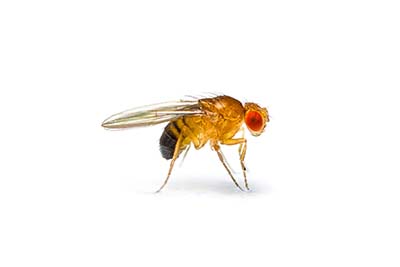Latin Name: Drosophila spp

Fruit flies are harmful pests that transmit dangerous diseases and contaminate food with pathogens. You can find them in markets, restaurants, cafeterias, hotels, residences, etc., where they cause significant contamination of fruits and other food products.
Fruit flies are 3 to 4 mm in size. Most of them have red eyes except for a few with dark eyes. They have a dull tan or brownish-black body with a dark abdomen. The larvae are usually white except for their black mouth hooks and yellow abdominal breathing pores.
Adult fruit flies have an antenna with a feathery bristle. They also have wings with thick front margins intersected in two places. They often exhibit sexual dimorphism, which makes their females about 2.5 mm longer than the males. You can differentiate the males from females based on their color. The males are known for their spiky hairs at their reproducing parts, which they attach to the females during mating.
Their eyes are sensitive to slight changes like light intensity. It makes them fly away as soon as they detect a shadow or other movement.
You can find fruit flies in places with rotten, decayed, or ripe fruits around. They like to make their homes in trash cans, mop buckets, drains, and garbage disposals. They also love to stay around fermented items like wine, beer, and liquor. Once they find a home in a place, the female flies can lay up to 500 eggs in less than 24-50 hours, making them difficult to control.
Just as their name suggests, fruit flies eat fruits, fermenting products, and vegetables. They also feed on honeydew secreted by aphids. You can find them outdoors in large numbers, especially during harvest seasons because they are at their peak. However, if you find them indoors, there is only one reason – they have a consistent food supply. They are primarily active during the day when there is overripe and decaying plant matter available.
During their preoviposition stage, adult fruit flies often feed on decaying materials, fruits, and vegetables. They are attracted to the initial decomposition of plant materials such as mushrooms and sap flows. After this phase, they take their time to lay their eggs underneath the skins of these fruits. Afterward, the eggs grow into larvae and survive by feeding on the surface of decaying fruits.
Fruit flies will often get into the homes during summer and spring through open doors and windows.
Fruit fly activity is seen mainly in the pupae and adult flies. The adult flies fly around the kitchens or trash cans with decaying fruits or vegetables. When they get into the home, you can find the mature larvae of the fruit flies crawling out of their breeding areas to pupate on dry areas. At this point, you can mistake them for rodent or cockroaches’ droppings. However, you can differentiate them by the pair of horns found at both ends of the pupae.
Aside from the nuisance they cause in the home, fruit flies can pick up dangerous diseases and contaminate food and anything they touch with pathogens and bacteria.
Take good care of your house and surroundings to avoid fruit fly infestation. As mentioned above, fruit flies are mainly found in sewage areas, drains, and garbage piles. So, take preventive measures regarding this. Some of the steps you can take are:
If you suspect these pests are in or around your home, give us a call for a Free Home Inspection!
